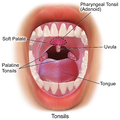Tonsil
Tonsil
The tonsils are a pair of soft tissue masses located at the rear of the throat (pharynx). Each tonsil is composed of tissue similar to lymph nodes, covered by pink mucosa (like on the adjacent mouth lining). Running through the mucosa of each tonsil are pits, called crypts.
The tonsils are part of the lymphatic system, which helps to fight infections. They are first line of defense in the immune system, "sampling" bacteria and viruses that enter the body through the mouth or nose.
Anatomy[edit]
There are three types of tonsils:
- Palatine tonsils. These are the two tonsils that are visible on either side at the back of the throat.
- Pharyngeal tonsil (adenoids). This tonsil is located higher up in the throat, behind the nose.
- Lingual tonsils. These tonsils are located at the base of the tongue.
Function[edit]
The tonsils play a role in the immune system and are meant to function like nets, trapping incoming bacteria and virus particles that are passing through your throat.
Diseases and disorders[edit]
Tonsils can become problematic, leading to a condition called Tonsillitis, which is an inflammation of the tonsils caused by either a bacterial or viral infection. Treatment of tonsillitis depends on the cause and the frequency of the illness.
Another problem can be the enlargement of the tonsils. This condition, called Tonsillar Hypertrophy, can cause snoring, mouth breathing, disturbed sleep, and other problems.
Treatment[edit]
Treatment for tonsil disorders depends on the cause and severity of the condition. If a bacterial infection is the cause of tonsillitis, antibiotics are usually prescribed. Chronic cases of tonsillitis or severely enlarged tonsils may require a Tonsillectomy, or surgical removal of the tonsils.
See also[edit]
References[edit]
<references />
Ad. Transform your life with W8MD's Budget GLP-1 injections from $75


W8MD offers a medical weight loss program to lose weight in Philadelphia. Our physician-supervised medical weight loss provides:
- Weight loss injections in NYC (generic and brand names):
- Zepbound / Mounjaro, Wegovy / Ozempic, Saxenda
- Most insurances accepted or discounted self-pay rates. We will obtain insurance prior authorizations if needed.
- Generic GLP1 weight loss injections from $75 for the starting dose.
- Also offer prescription weight loss medications including Phentermine, Qsymia, Diethylpropion, Contrave etc.
NYC weight loss doctor appointmentsNYC weight loss doctor appointments
Start your NYC weight loss journey today at our NYC medical weight loss and Philadelphia medical weight loss clinics.
- Call 718-946-5500 to lose weight in NYC or for medical weight loss in Philadelphia 215-676-2334.
- Tags:NYC medical weight loss, Philadelphia lose weight Zepbound NYC, Budget GLP1 weight loss injections, Wegovy Philadelphia, Wegovy NYC, Philadelphia medical weight loss, Brookly weight loss and Wegovy NYC
|
WikiMD's Wellness Encyclopedia |
| Let Food Be Thy Medicine Medicine Thy Food - Hippocrates |
Medical Disclaimer: WikiMD is not a substitute for professional medical advice. The information on WikiMD is provided as an information resource only, may be incorrect, outdated or misleading, and is not to be used or relied on for any diagnostic or treatment purposes. Please consult your health care provider before making any healthcare decisions or for guidance about a specific medical condition. WikiMD expressly disclaims responsibility, and shall have no liability, for any damages, loss, injury, or liability whatsoever suffered as a result of your reliance on the information contained in this site. By visiting this site you agree to the foregoing terms and conditions, which may from time to time be changed or supplemented by WikiMD. If you do not agree to the foregoing terms and conditions, you should not enter or use this site. See full disclaimer.
Credits:Most images are courtesy of Wikimedia commons, and templates, categories Wikipedia, licensed under CC BY SA or similar.
Translate this page: - East Asian
中文,
日本,
한국어,
South Asian
हिन्दी,
தமிழ்,
తెలుగు,
Urdu,
ಕನ್ನಡ,
Southeast Asian
Indonesian,
Vietnamese,
Thai,
မြန်မာဘာသာ,
বাংলা
European
español,
Deutsch,
français,
Greek,
português do Brasil,
polski,
română,
русский,
Nederlands,
norsk,
svenska,
suomi,
Italian
Middle Eastern & African
عربى,
Turkish,
Persian,
Hebrew,
Afrikaans,
isiZulu,
Kiswahili,
Other
Bulgarian,
Hungarian,
Czech,
Swedish,
മലയാളം,
मराठी,
ਪੰਜਾਬੀ,
ગુજરાતી,
Portuguese,
Ukrainian




